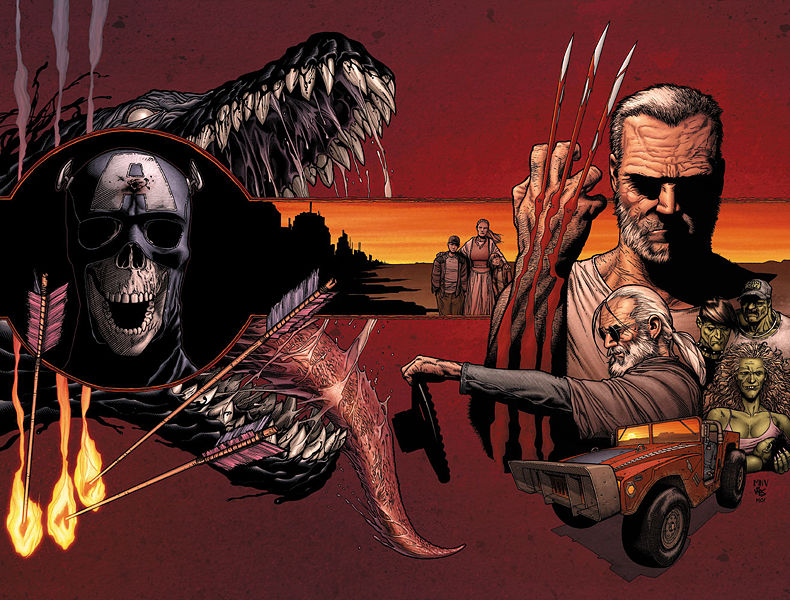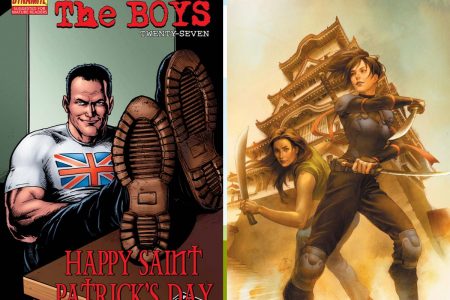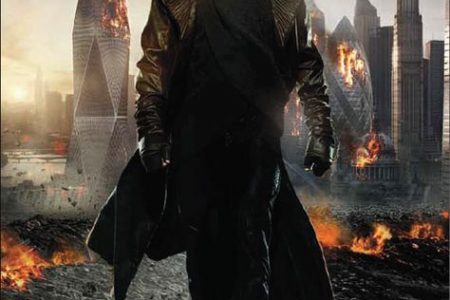Wolverine #66–72 and Wolverine: Old Man Logan Giant-Size by Mark Millar and Steve McNiven
I haven’t purchased a Mark Millar comic book in ages – his overbearing hucksterism, his ‘film pitch as comic book’ approach, and his seeming dislike for people who read comic books make for an unpleasant taste in the mouth, metaphorically speaking. However, sometimes my lack of judgement gets the better of me, such as when I saw this book in the library and brought it home.
Millar’s success is based on a mixture of easy-to-grasp concepts (which are not original but he promotes them as such), shock tactics and clear storytelling. He is good at taking ideas that have worked in other forms and transposing them to comic books. Case in point: Old Man Logan is essentially Clint Eastwood’s Unforgiven, with some extra road movie thrown in, with Marvel’s Acts Of Vengeance crossover from 1989 as a starting point. He doesn’t hide it: the opening spread is Logan on a horse. Set 50 years in the future, Logan is a farmer with a wife and two kids who needs money to pay rent to his landlords, the grandchildren of Bruce Banner. So when a blind Hawkeye turns up (in the Morgan Freeman role) and offers him a job accompanying him across this new America (a handy double-page spread of a satnav shows how the country is split into domains), he takes it and we start the road movie section (driving the Spider Mobile, because it’s funny, I guess?).
The road movie section is a plot distraction – it’s just to show off this new world of Millar’s, including a very odd side chapter about Hawkeye’s daughter (who is also Peter Parker’s grandchild, which is pretty icky – Hawkeye having sex with Parker’s daughter? – but it is an indicator of Millar’s level for later), which sees the gratuitous deaths of Frank Castle and Matt Murdock, opportunities for Hawkeye to kill some fools, the explanation of why Logan is no longer Wolverine and also includes a Venom T-Rex. We see the corpse of Giant Man decomposed to a skeleton – Hawkeye dies as well, which he has to because he’s Morgan Freeman, remember? – and the death of all the X-Men, because Millar really loves superheroes, which is why he kills them all the time (see Civil War and the zombie world in his Fantastic Four story). Then, after all of this time, Logan dispatches the bad guy in a few pages (in a set of ridiculous circumstances) before finally we get to the entire point of the story: Logan releasing his claws and going psycho. This is so monumental that it warrants a double-page spread that is just the word ‘SNIKT!’ in red letters on black background. Sigh.
The thing that annoys me about this comic book is the sloppy plotting that Millar uses to justify the ‘coolness’ of his story (which is his modus operandi). The biggest problem I have is with the whole reason that Logan no longer fights: it’s because he killed the X-Men while under the hypnotic influence of Mysterio. This is completely unbelievable nonsense on so many levels that Millar doesn’t even attempt to explain how it is possible for Mysterio to have hoodwinked Wolverine, or that Wolverine is able to kill all of the X-Men without any of them stopping him – it makes me angry to think he was allowed to get away with such an obvious plot hole, especially when it’s critical for the story. What’s worse is that, after getting Logan to kill the X-Men, the villains just let him go (if the whole point is to kill all the superheroes, why let him live?) and let him live as a farmer for 50 years. He’s that dangerous but he’s allowed to survive. Completely illogical.
Then there are the embarrassing coincidences that allow Logan to kill the Red Skull – he is the president of the former United States, having succeeded in the Acts of Vengeance (albeit without Loki, who was the instigator originally – we see Loki’s skeleton in the road section, just to clarify this), and given areas of the country to his helpers. We find him gloating in his trophy room [which has a Punisher t-shirt in the trophy cabinet, even though Punisher only died a day or two earlier in another part of the country; also, why was Moon Knight, whose cowl is in the trophy cabinet, killed but not Hawkeye or Punisher or Daredevil?] in the White House – because that’s what the Red Skull does – while wearing Captain America’s cowl because this is funny, I guess? Anyway, this just happens to be where Skull’s agents bring the corpse of Logan (because that makes sense), which provides Logan with Cap’s shield to poetically kill the Skull (he has yet to pop the claws). Then there is an Iron Man armour for Logan to escape the White House, because it’s cool, of course.
The story finishes with Logan, his family slaughtered by Banner’s grandkids, hunting down and killing Bruce Banner and his inbred redneck family (Banner sired kids with Jennifer Walters, aka She-Hulk, his cousin, because Millar has the sensibility of an adolescent); Logan is apparently able to kill Banner from the inside when Bruce ate him, which makes no kind of sense, but what are you going to do? The finale sees Logan doing his version of Lone Wolf and Cub by taking Banner’s youngest grandchild and going on the road to kill all the supervillains. I think this is supposed to be the happy ending.
This is also an incredibly violent comic book – Hawkeye’s daughter decapitates a man by hitting his neck with the handle of a shotgun, not to mention Wolverine’s slaughter in the X-Mansion and the Banner family; he also gets some of his own decapitation act with a Cap shield/Red Skull interface. I must be getting old because ‘Parental Advisory’ on the back doesn’t seem strong enough. However, McNiven does a good job drawing this ultraviolence; he’s a very talented artist, with a sharp line and clean storytelling. All his characters look like individuals and he’s great at picking those shots that say more than a narrative caption could. It’s just a shame that it’s for something like this.




